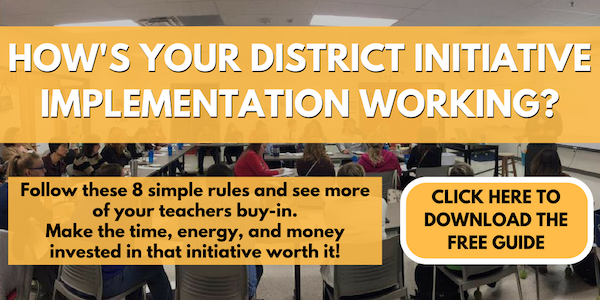TL;DR:
- The transition to remote learning has taught us quite a few new things.
- Taking this learning into the next school year, and beyond.
I don’t know about you, but as we get further and further into the weeks of remote learning, a few things become more evident.
(1) We have all been thrown into the deep end.
(2) We are strong enough to handle a crisis.
(3) Every day is filled with learning opportunities (for us!).
(4) There will be another transition ahead.
I had a phone call earlier this week with a few district leaders eager to find the right message they need to kick off the next school year. It’s not that anyone on the phone was willing or eager to call school off for the spring; however, regardless of how the next few months go, education has changed.
So, how do you kick off August the right way in this new era of education?
Here are 3 key elements that need to be a part of your Fall 2020 Institute Day message to set the tone.
We were thrown into the deep end and proved we were strong enough to handle a crisis.
COVID-19 will be the elephant in the room this August. Therefore, address the challenges and present the silver linings that emerged from this challenging time. During this time, leadership saw the power in its community, and while working hours changed and stress heightened, you stood united. Provide specific shoutouts of educators, community leaders, and students who went out of their way to find hope during this time.
And more than ever, highlight the bravery of your staff for being thrown into the deep end of the pool and never giving up as they persevered to find the right stroke.
During times of crises, educators – natural problem solvers – become stronger. Teachers have done more this spring than simply educate students from a distance. They have educated parents and community leaders in the process. And, through all the turmoil, they have arrived back in your building in the fall eager to take on a new challenge for the second half of 2020. Celebrate this commitment with your school family.
During times of crises, educators - natural problem solvers - become stronger. Share on XEvery day was filled with learning opportunities. Do not allow those lessons to fade.
The most challenging part shifting from the classroom teachers facilitated in February to the one they lead in April was the learning curve. Many educators signed up for technology resources, scoured for blogs with educator tutorials, and surveyed students week-to-week to improve their craft. This – if nothing else – was the time for learning, taking a chance, experiencing failure, reflecting, and starting again.
Share your celebration of this experience with staff and take the necessary time to allow teachers to share their stories. Find a balance to make this experience both light-hearted and purposeful. Share the stories of failed web-cameras, which completely changed a lesson for the worse, to massive celebrations of students taking their learning more deeply than we, as teachers, ever expected.
Make a list of the experiences for all of your staff to see, and don’t allow these stories to fade as we enter into a new phase of education this fall.
There will be another transition ahead of us.
The truth is, we can all head back into classrooms in the Fall of 2020 and go back to our old normal. But the normal we have upon us will never be the same as the one that once was. We are different. Students are different. Families are different. Education is different.
And, regardless of the challenges we have faced, we must choose the tougher, more intentional pathway. Choose to take what we have learned and be better.
The number one message your staff needs to experience is your message of being a partner in helping every educator find their new normal. In taking the experiences they have faced during COVID-19 and continuing forward as they arrive back this fall as a stronger educator.
This will take time and multiple conversations. Facilitate conversations and learning opportunities for your teachers to identify what they have learned and how these elements can transition back to their classrooms.
Use a new tracking page to manage students?
Consider facilitating a self-paced classroom similar to remote learning to allow students to continue taking ownership over learning.
Found a new way to motivate students outside of assigning a grade?
Continue this is the classroom and do not allow a grade being the main source of motivation for student buy in.
Utilize a new tool for instruction?
Find purposeful ways to incorporate tools into students daily learning opportunities.
Grow your PLN and brainstorming team?
Don’t lose your virtual connections. Continue to reach out to others outside of your physical space to research new tools and try new strategies.
Communicate more to families?
Make sure to continue to educate families even while not at a distance. They are our partners in this process.
Love a new Podcast?
Don’t stop learning. Schedule purposeful times to continue enjoying other educational outlets to learn.
Still striving to balance Teacher Care?
Make sure, even while back in the classroom, you are taking care of yourself. Set up boundaries and stick to them.
Continue the growth, much past August.
We must all continue to be learners – even while coming out of this challenging time. Be the leader we all need and send the right message this August as we address the elephant in the room and create a better school system because of it.
Why? Because #TeachersDeserveIt
[scroll down to keep reading]
About Rae Hughart
Rae Hughart is a Middle-Level Math and Writing Educator in Illinois, the Director of Training and Development for the Teach Better Team, and co-author of the Teach Better book. In 2017, Rae was honored with the Illinois State University Outstanding Young Alumni Award – inducting her into the University Hall of Fame. In 2018, Rae was honored again by the Henry Ford Innovator Award for her work within educators communities to build unity between local businesses and schools. Rae is also a member of the Teach Better Speakers Network.


